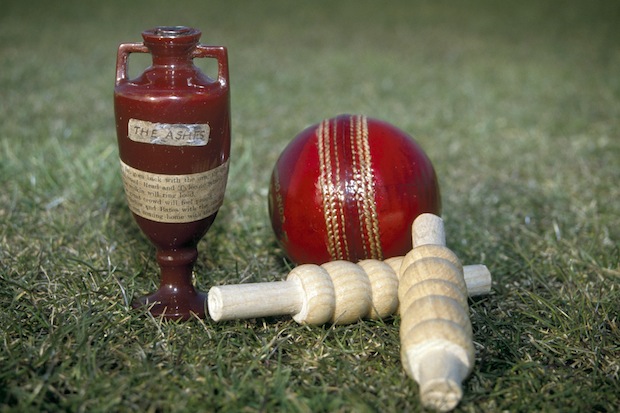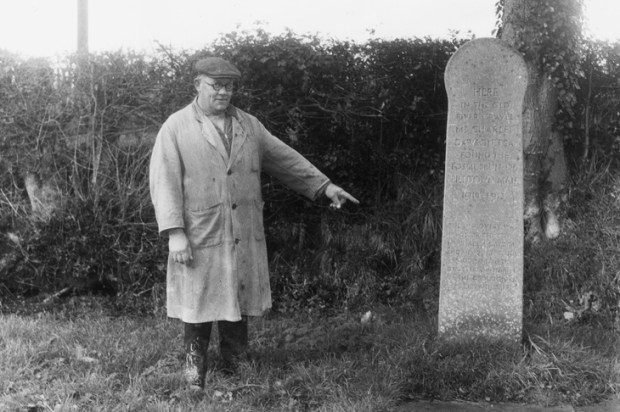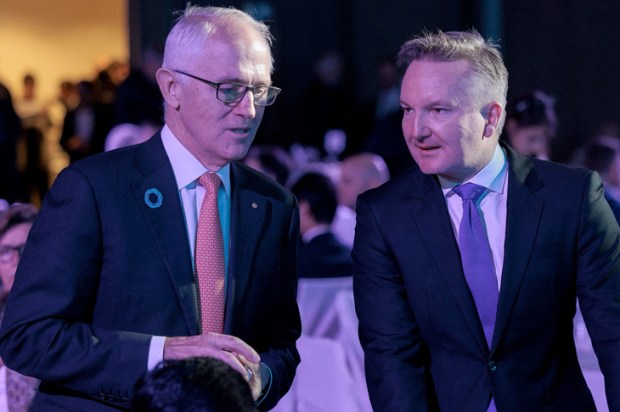‘Let no man boast himself that he has got through the perils of winter til at least the seventh of May,’ cautioned Anthony Trollope. The English spring of 2013 has made that aphorism appear the height of optimism. Winter’s cold, damp hand only relinquished its grip in recent weeks. The northern summer heralds those most familiar of sporting rituals: Wimbledon, Royal Ascot — and England’s oldest sporting rivalry.
The Ashes series is the sclerotic, barely functioning artery that links the current crop of pampered, celebrity professionals to the rich poetic heart of the summer game, with its legends and granite figures like Bradman, Hutton, Larwood, Davidson, Harvey, the Chappells, Lillee and Thomson, Boycott and Snow. There is no other sporting rivalry quite like it, no interrogation quite so searching and sustained as five Test matches, each over five days compressed into a matter of weeks.
And despite the changing demographic and cultural complexions of both England and Australia, the Ashes is still able to mobilise popular sentiment. Indeed, Australia’s resentment of English supremacy can only be adequately understood in the context of our long evolution from a sparsely populated, derivative, English settler society to a proud cosmopolitan nation. Cricket was one of the earliest ways a burning sense of colonial inferiority could be expunged, through victory over the Imperial power.
Indian cricket, especially in its embryonic emergence in Bengal, exhibited the same paradoxical blend of insecurity and assertiveness, which was given shape by the fierce desire of the locals to earn the respect of their overlords. Even Australia’s emergence as a modern, sophisticated, Indo-Pacific nation has not fully extinguished that primal desire to prove itself against England in any sporting contest. But cricket remains the ultimate measure of national morale.
After almost uninterrupted humiliation by the hegemonic Australian team from 1989 until 2005, English cricket has undergone a startling Renaissance since their hard-won victories at home in 2005 and 2009. Both were epic series.
Australia, still boasting Warne, McGrath, Gilchrist, Hayden and Ricky Ponting, routed the tourists here in 2006-7 only to succumb in ignominious fashion at home in 2010-11. The rationalisation then was that too many truly great players had retired simultaneously.
But the unraveling of the Australian team in India in March this year suggested that the managerial response of the Argus review and the reassuring rhetoric of consultancy firms were not compensating for deeper structural and cultural problems in the game.
As the late Peter Roebuck astutely observed, even before the advent of the sugar-coated Big Bash, Australia’s cricket production line had broken down. We are now reaping the whirlwind of commercialisation, which rewards technically and temperamentally deficient but exciting players. Too few of our putative Test batsmen are playing sufficient red ball cricket.
To me the question of whether this is the worst Australian team to tour England is moot. They possess a pace attack of vigour and hostility, which will find conditions here more amenable than those in India, where the pitches looked like drop-ins from Roland Garros. In Ryan Harris, Mitchell Starc, James Pattinson and Jackson Bird, Australia possess an aggressive pace attack, balancing express pace with more subtle movement in the air and off the seam. New Zealander Tim Southee’s ten-wicket haul at Lord’s in May demonstrated that England are far from invincible against even honest journeymen who nag away on a good line and length.
Yet their ruthless recovery to win that Test match from an apparently impossible position should have sent shudders through the Australians. It demonstrated mental toughness and resilience from a team accustomed to winning from difficult positions, qualities once associated with the Australian teams of our most recent Golden Age.
Moreover, success breeds success. The top five in the English batting order have compiled 76 Test centuries among them. Prima inter pares is their captain, Alastair Cook, who became the youngest man ever to accumulate 7,000 Test runs and has already eclipsed all the greats of English cricket in becoming their highest scorer of Test centuries at a tender 28. Australia’s trump card is our pace attack. But matched up against the daunting arithmetic that defines this English batting order it is difficult to envisage their taking 20 wickets, the sine qua non of victory.
The only Australian batsman worthy of comparison to Cook is our own captain, Michael Clarke. However, his recurring back injury has impeded his preparation. He is the lynchpin of an unsettled and brittle batting order. According to the doyen of Australian cricket statisticians, Ric Finlay, Australian batsmen have compiled only two centuries from their 128 recently completed individual innings. The comparison with the English top order is stark and troubling.
Moreover, it is clear that Clarke does not lead a harmonious, focused unit. The fractious relations between the captain and Shane Watson have the capacity to reverberate right through the team. Watson exhibits a deep sense of entitlement to occupy his preferred spot in the batting order. He wants to open the innings and bowl as whim dictates.
Yet his record is that of a promising all-rounder who needs to bowl well and often to compensate for unfulfilled batting promise. His is an unlikely cause célèbre for the old guard of Australian cricket, most eloquently and incisively represented by Ian Chappell. But his recent form against Somerset suggests he will be restored to the top of the order.
Far from Trent Bridge and the temperate English summer, I sat in the media box at the sun-drenched Adelaide Oval with Chappell in January 2012 discussing whether, in light of Australia’s resounding defeat of India, we may be on the cusp of a resurgence similar to that launched by his 1972 touring team.
In preparing this piece I had cause to consult my notes of our chat. His predictions that should Mike Hussey and Ricky Ponting have retired ahead of this series then Australia’s emerging Test batsmen would not be up to the task now look remarkably prescient. So did his reservations about the depth of our spin bowling department.
The day after the Trent Bridge Test is St Swithin’s Day. According to a superstitious rhyme:
St Swithin’s day if thou dost rain
For forty days it will remain
St Swithin’s day if thou be fair
For forty days ’twill rain nae mair.
A rout at Trent Bridge may leave some Australian fans hoping for a wet summer to provide respite from the English assault.
Got something to add? Join the discussion and comment below.
Get 10 issues for just $10
Subscribe to The Spectator Australia today for the next 10 magazine issues, plus full online access, for just $10.
Cate McGregor is The Spectator Australia’s cricket writer.
You might disagree with half of it, but you’ll enjoy reading all of it. Try your first month for free, then just $2 a week for the remainder of your first year.














Comments
Don't miss out
Join the conversation with other Spectator Australia readers. Subscribe to leave a comment.
SUBSCRIBEAlready a subscriber? Log in